Caïssa Britannia (originally British Chess)
Caïssa Britannia, originally known as British Chess, is based on an idea I had in 2001 to create a British themed Chess variant with Lions, Unicorns, Dragons, and a royal Queen. Lions, Unicorns, and Dragons are respectively the heraldic animals for England, Scotland, and Wales. The Queen is the royal piece, because the current British monarch is a Queen. I tried some combinations of Lions, Unicorns, and Dragons from fairy chess and chess variants, but I wasn't satisfied with the results. There was also the problem of making the game fairly playable with a royal Queen. I initially made baring the Queen a winning condition, but I was never satisfied with this. I really wanted a game in which a Queen could be checkmated merely by a Queen and another piece. I put the ideas for the game aside for a while, then returned to them in January 2003. I decided to create my own Dragon instead of pulling one from fairy chess or another variant, and I drew some inspiration from castling and Chinese Chess to limit how the royal Queen can move. I now have a game I'm satisfied with.
Although the name of British Chess directly reflects the idea behind this game, it will be less appropriate when the monarch is once again a King. Because of this, British Chess also bears the alternate latin name of Caïssa Britannia. This name better reflects the Queen-centered nature of this game. This name suggests a royal Queen, as Caïssa is the name for the female personification of Chess, sometimes regarded as the muse or goddess of Chess, and Britannia is the name for the female personification of Britain. So both parts of the name suggest a female royal piece. In addition, Christian Freeling has already used the name Caïssa for another Chess variant with a royal Queen, setting a precedent for associating Caïssa's name with the royality of the Queen. Also, the name of British Chess sounds like it belongs to a regional variant, along the same lines as Chinese Chess, Burmese Chess, etc. Yet this game is not a regional variant. In contrast, the name of Caïssa Britannia is more poetic and less regionally descriptive, suggesting a thematic association with Britain, which is all that is British about this game, without implying a British origin.
Although not strictly British in origin, this game was created in a former British colony that was named for a place in Britain (York). Its creator, Fergus Duniho, is ethnically part Irish, Scottish, and English. His native language is the same as it is for the British (English), and he lives almost on the border of the British Commonwealth nation of Canada. Politically speaking, the creator of British Chess is an American. Culturally speaking, he is American, British, and Canadian. Also, his birthday falls on St. George's Day, which is the national holiday for Great Britain, sort of like the American 4th of July.
Setup
|
satellite=caissa
files=10
ranks=10
holdingsType=1
promoZone=1
maxPromote=1
promoChoice=N*D*B*R*L*Q*U
royal=9
graphicsDir=/graphics.dir/alfaeriePNG/
squareSize=50
whitePrefix=w
blackPrefix=b
graphicsType=png
darkShade=#2F2F8F
lightShade=#DFDFDF
oddShade=#9F2F2F
rimColor=#000000
coordColor=#FFFFFF
useMarkers=1
borders=0
firstRank=1
symmetry=mirror
pawn::::a3-j3
knight:N::::10
dragon::DDAA::a1,j1
(anglican) bishop:B:BmW:bishop:d1,g1
prince consort::mQK:king:f1
rook::::b1,i1
lion::mQcpQ::b2,i2
unicorn::BNN::c1,h1
royal Queen:Q:nQ:queen:e1
|
|
Q/q = Queen, K/k = Prince Consort, R/r = Rook, B/b = Bishop, D/d = Dragon, U/u = Unicorn, L/l = Lion, P/p = Pawn, and N/n = Knight. Capital letters are white, and lowercase letters are black.
Pieces
 Queen |
The Queen is the royal piece in this game. It slides any number of spaces along a diagonal or orthogonal line, just as the Queen in Chess does, but it may not pass over any space it would be illegal for it to move to. This includes any space on which it would be in check or on which it would be facing the opposing Queen. This restriction on the Queen's movement makes it easier to checkmate, which makes the game much less drawish than it would be otherwise. (Technically speaking, this is functionally equivalent to the rule that a Queen may not move through check except when moving to capture the enemy Queen, but this alternate description of the rule, which is mainly a technical description for how it can be programmed, confuses some people. The general idea is that Queens may not face each other, because that would put them in check, and a Queen may not cross over a space covered by the other Queen, because it would be moving through check.) |
 Prince Consort |
The Prince Consort is the Queen's husband. It replaces the King from Chess. The Prince Consort may capture by moving one space in any radial direction, or it may slide like a Rook or Bishop without capturing. Although it has only short-range powers of capture, its power to capture a piece on any adjacent space is enough to make it invulnerable to long-range attacks from a Queen. Since a Queen cannot pass through check, it cannot capture a Prince Consort unless the Prince Consort has already moved adjacent to it. |
 Lion |
The Lion was created by T. R. Dawson, who called it a Leo. The Lion moves as a Cannon or a Vao. In other words, it moves as a Rook or a Bishop, except that it must jump an intervening piece, called a screen, to capture another piece. |
 Unicorn |
The Unicorn was created by David Paulovich for Unicorn Chess. This piece moves as a Bishop or a Nightrider. It may ride on diagonal lines like a Bishop, or may make consecutive Knight leaps in the same direction until it captures a piece or is blocked. |
 Dragon |
This piece was created by Fergus Duniho for this game. It is a compound of an Alfilrider and a Dabbabarider. It may make any number of consecutive two-space leaps in the same radial direction, so long as each leap except the last lands on an empty space. It may cover only a quarter of the board, which makes it weaker than other pieces, but its powers of movement do make it invulnerable to attacks from the Queen beyond a two-space perimeter. Since a Queen may not pass through check, it must already be within two spaces of a Dragon to capture it. |
 Rook |
The Rook is just like the Chess Rook, except that it does not castle. It slides along orthogonal lines, so long as it isn't blocked. |
 Bishop |
Since this game is British in theme, the Bishops are Anglican instead of Catholic. Unlike the Catholic Bishops, who took a vow to remain on one color, the Anglican Bishops didn't make this vow. In addition to sliding diagonally, as the Chess Bishop does, the Anglican Bishop may step one space orthogonally without capturing. This piece effectively combines the moves of the Bishop and the Steward. |
 Knight |
The Knight is just the same as it is in Chess, but it doesn't appear in the initial setup. It is offered only as an additional piece a Pawn may promote to. |
 Pawn |
The Pawn moves the same as the Chess Pawn. Pawns start on a different rank, but they can still make double moves and capture by en passant. Only the promotion rules are different. Upon reaching the last rank, a Pawn liberates a captured piece or gets knighted. This means a promotion to a captured piece or to a Knight. The option of promoting to a Knight enables the Pawn to move to the last rank when there are no captured pieces to promote to. |
Rules
Aside from differences in board, pieces, and setup, British Chess is played like international Chess with the following differences:
- The object is to checkmate the enemy Queen.
- The two Queens may never face each other across an empty diagonal or orthogonal line.
- A Queen may not move into check.
- A Queen may not move through any space it would be illegal for it to move to.
- There is no castling
- A Bishop may change color by stepping one space orthogonally to an empty space.
- Upon reaching the last rank, a Pawn may promote to a Knight or to any captured piece belonging to the same side.
Playing Tips
This game has three major pieces and four minor pieces. The major pieces are the Unicorn, Rook, and Prince Consort. The minor pieces are the Lion, Dragon, Bishop, and Knight. Against a lone Queen, a Queen plus any two minor pieces are normally sufficient for checkmate. The only combination of two minor pieces that cannot force checkmate are two Dragons when they are both on dark squares or both on light squares. But this can happen only when a Pawn promotes to a Dragon, and this will rarely ever happen, since a Pawn can always promote to something else, even if only to a Knight. So, for practical purposes, we may just say that a Queen and any two minor pieces are sufficient for checkmating the enemy Queen. But that is not the end of it.
Unlike in Chess, where one King may never fully trap another, one Queen may trap another in a corner, which can allow a single minor piece to checkmate the trapped Queen. This almost gives a minor piece the power of a major piece, but not quite, because trapping a lone Queen would result in stalemate before the minor piece could move in for checkmate. For a Queen and minor piece to checkmate a Queen on their own, the opponent must have another piece that may move after the Queen is immobilized, yet also be unable to stop the impending checkmate with this piece. The extra power that Queen/minor piece combinations have in this game makes the minor pieces semi-major pieces rather than mere minor pieces. A semi-major piece is one that can checkmate an isolated, though not lone, royal piece with help only from one's own royal piece. An isolated royal piece is one that is cut off from support without being the only piece of its color on the board. Also, semi-major pieces differ in endgame utility. In this game, the Bishop and Knight have the most endgame utility of all minor pieces, followed by the Dragon, with the Lion having the least. But the overall value of a piece is measured not only in endgame utility but also in mobility and midgame utility. With all this in mind, let's look at the pieces, beginning with the major pieces.
The Unicorn is probably the most powerful piece in the game. Of all the pieces, it is the only piece that can checkmate a Queen without help from another piece. This makes it a super-major piece. Its long-range attacking ability is very useful. Its achilles heel is that it is open to orthogonal attacks from the enemy Queen. When it tries to maneuver around the Queen at close range, the Queen can keep moving to attack it rook-wise. So, despite its ability to force mate on an empty board, it sometimes can't force mate without help from another piece.
The Rook has a long-range attack that is generally more powerful than any of the Unicorn's long-range attacks, but it has only four directions of attack instead of the twelve available to the Unicorn. It remains vulnerable to the Queen's diagonal attacks.
The Prince Consort has no long-range attack, but it's very good at forcing mate when it's up close and protected. One advantage it has over the other major pieces is that it is invulnerable to long-range attacks from the enemy Queen. A Queen may capture a Prince Consort only from an adjacent space.
The Lion is a very powerful piece during the mid-game, though its value may diminish in the endgame. The Lion is the only piece in the game that can pin two pieces with the same line of attack. This makes it very useful for immobilizing enemy pieces for easy picking off by other pieces. It is also useful for opening up lines of attack for other pieces, because one way to stop a Lion's attack is to move the screen piece out of the way. It is also good at forking pieces, because most pieces it attacks cannot jump over the screen to capture it. The pieces it is most vulnerable to are Dragons and other Lions. It is also vulnerable to the enemy Queen when nothing stands between them.
The Anglican Bishop is more powerful than the Chess Bishop, because it can move between dark and light squares, allowing it to cover the whole board.
For a piece that is limited to one quarter of the board, the Dragon is suprisingly powerful. It is very useful for protecting spaces while remaining safely across the board behind other pieces. One good way to checkmate a Queen is to move the Prince Consort next to the Queen while protecting it with a Dragon. When two Dragons occupy the same rank or file, they can secure it about as well as a Rook, sometimes better, because it will take two pieces to block them. Thus, two Dragons working together can be very helpful in preventing the enemy Queen from moving beyond her present rank or file. The Dragon is also one of the best pieces for defense, because it can easily protect several pieces even when other pieces stand between them. Although the Dragon is not the quarterback of this game, it is very useful for backing up and supporting attacks from other pieces.
Although the Knight has no long-range movement, it can attack any piece but the Unicorn or another Knight without that piece being able to capture it.
Computer Play
If you have version 2.0 of Zillions of Games installed on your computer, you can play this game. Download file: britishchess.zip.
You can also play this game with other online by means of Game Courier, our online play-by-mail system.
Equipment
Play on a 10x10 board. While playing on an ordinary two-color board is okay, playing on a three-color board, as illustrated above, will aid in the visualization of Dragon moves and the Nightrider moves of the Unicorn. Use regular Chess pieces for every piece but the Lions, Unicorns, and Dragons. Use Chess variant pieces if you have them, or use pieces from a Chess set in another style or size.
You can get the extra pieces you need to play this game from three different Musketeer Chess Variant kits. You can get the Lion from the Lion & Rhinoceros set, the Unicorn from the Fortress & Unicorn set, and the Dragon from the Dragon & Camel set. Note that the sets come in two different color options, and you will need two of each set to have two Lions, two Unicorns, and two Dragons for each side.
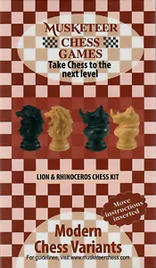
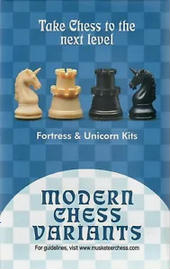
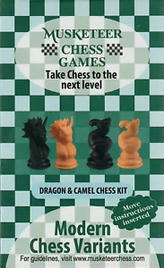
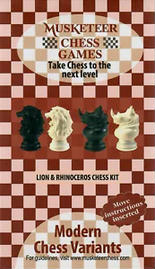
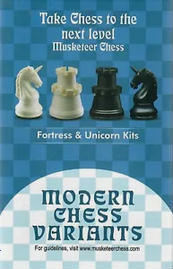
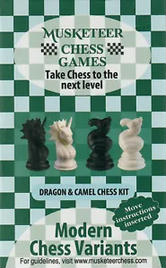
Written by Fergus Duniho.
WWW page created: January 19, 2003
